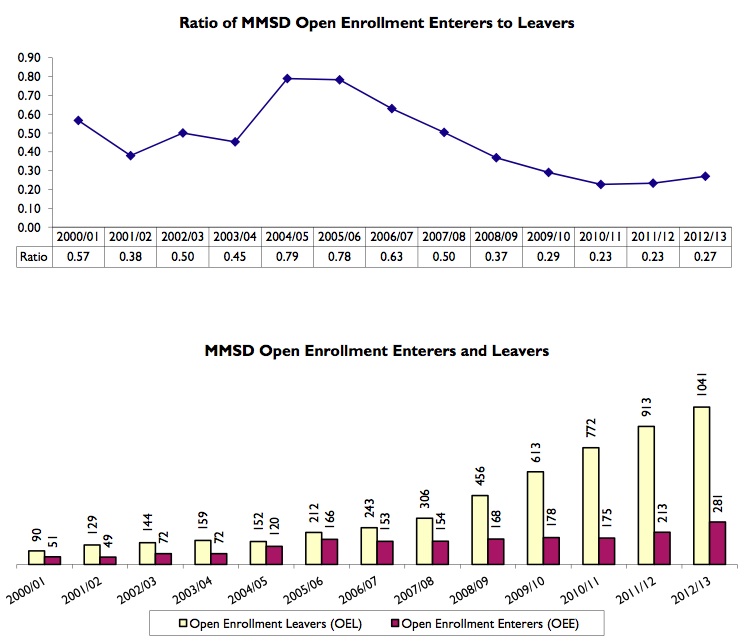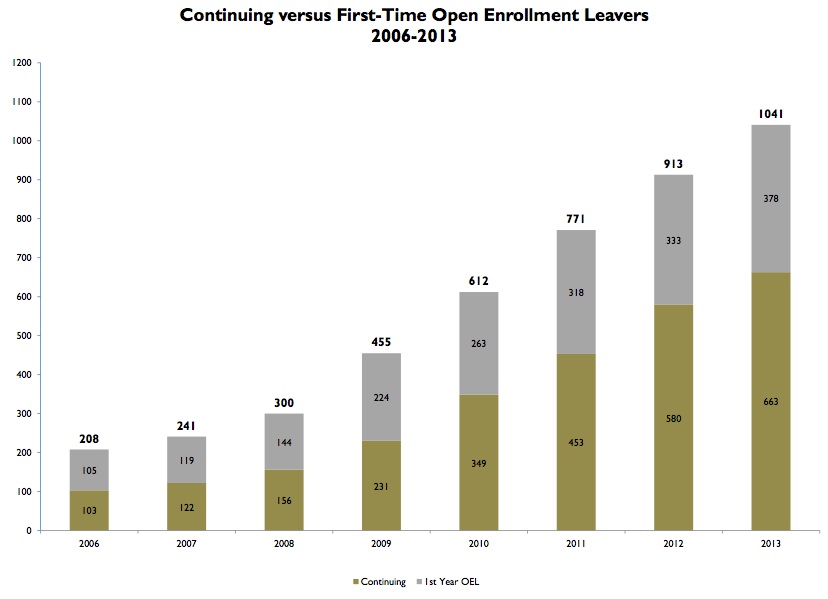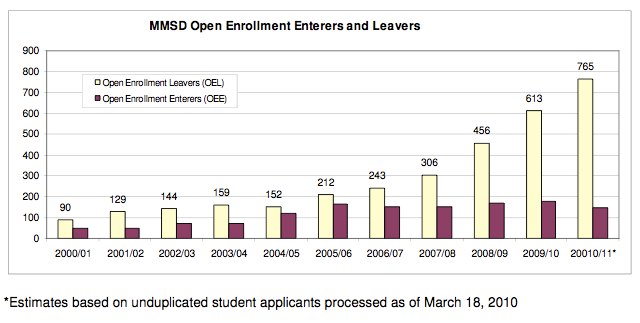Search Results for: %22Open Enrollment%22 Leaver Survey
Open Enrollment Survey and Data Update – Madison School District
Madison School District Administration (PDF): 1. In total, MMSD has 365 open enrollment enterers and 1294 open enrollment leavers for 2016-17; among those 1294 leavers, 58% have never enrolled in an MMSD school. 2. The net effect of open enrollment decreased by 70 students. The number of open enrollment leavers decreased by 21 students and […]
Madison School District Open Enrollment Leavers Report, 2012-13
Superintendent Jane Belmore (700K PDF):For the 2012-13 school year, MMSD has 1041 leavers and 281 enterers for a net enrollment decrease of 760 students due to open enrollment.
Of the 1041 leavers for 2012-13, 663 were “continuing leavers” who open enrolled outside of the District in previous years. The other 378 leavers left MMSD for the first time this year.
The increasing number of total leavers in recent years results from many consecutive years of increases in first-time leavers who subsequently become continuing leavers.
First time leavers increased from 333 to 378 from 2011-12 to 2012-13.
About 40% of the MMSD residents who open enroll outside of the district for the first time never attended MMSD and could be considered “stayers” for other districts.
A 2009 survey of open enrollment leavers showed that personal preference led to about one third of the decisions to leave, including concerns about safety, drugs and negative peer pressure. Proximity to other districts’ schools accounts for about a quarter of the reasons for attending another district. About a quarter were related to curricular, after school or virtual programs.Related: Much more on “open enrollment”, here, and the Madison School District’s enrollment forecast (PDF).
Madison School District Open Enrollment Enterers & Leavers
Under Open Enrollment, students may transfer into an MMSD school from another district or transfer out to another district – “enterers” versus “leavers.” This report focuses primarily on Open Enrollment leavers. There is also some discussion of the net effect of Open Enrollment, which is the number of leavers minus the number of enterers. This report does not discuss students attending private/parochial schools or home schooled students.
For the 2011-12 school year, MMSD has 913 leavers and 213 enterers for a
net effect of 700 students choosing to attend a district other than MMSD.
Of the 913 leavers for 2011-12, 580 were “continuing leavers” meaning they open enrolled outside of the District in previous years. That leaves 333 first time leavers for the current school year.
The growing number of leavers in recent years is the result of a cumulative increase over several years – those who are continuing leavers are still included in our counts in the following years. Because of this, it will take time to reverse the net number of leavers and first time leavers are of particular interest.
First time leavers increased only slightly from 2010-11 to 2011-12. If we discount the one-time bump for the first class of 4K, the number of first time leavers went down for the first time since at least 2005-06.
It is also important to note that nearly half of the students that are leavers never attended MMSD and could be considered “stayers” for other districts.
In terms of why people leave the district, we rely on a 2009 survey of leavers.
An Update on Open Enrollment & The Madison Schools
Molly Beck: There are 1,203 students living within the Madison School District’s boundaries who have enrolled in other school districts this school year — about 62 more than last year. The number of students from other districts who enrolled in Madison schools is 372, up by about 73. The net effect is a loss of […]
As the Madison school year starts, a pair of predicaments
Paul Fanlund, via a kind reader:
In fact, the changing face of Madison’s school population comes up consistently in other interviews with public officials.
Police Chief Noble Wray commented recently that gang influences touch even some elementary schools, and Mayor Dave Cieslewicz expressed serious concern last week that the young families essential to the health and vitality of Madison are too often choosing to live outside the city based on perceptions of the city’s schools.
Nerad says he saw the mayor’s remarks, and agrees the challenge is real. While numbers for this fall will not be available for weeks, the number of students who live in Madison but leave the district for some alternative through “open enrollment” will likely continue to grow.
“For every one child that comes in there are two or three going out,” Nerad says, a pattern he says he sees in other urban districts. “That is the challenge of quality urban districts touched geographically by quality suburban districts.”
The number of “leavers” grew from 90 students as recently as 2000-01 to 613 last year, though the increase might be at least partly attributed to a 2007 U.S. Supreme Court ruling that greatly curtailed the ability of school districts to use race when deciding where students will go to school. In February 2008, the Madison School Board ended its long-standing practice of denying open enrollment requests if they would create a racial imbalance.
Two key reasons parents cited in a survey last year for moving children were the desire for better opportunities for gifted students and concerns about bullying and school safety. School Board member Lucy Mathiak told me last week that board members continue to hear those two concerns most often.
Nerad hears them too, and he says that while some Madison schools serve gifted students effectively, there needs to be more consistency across the district. On safety, he points to a recent district policy on bullying as evidence of focus on the problem, including emphasis on what he calls the “bystander” issue, in which witnesses need to report bullying in a way that has not happened often enough.
For all the vexing issues, though, Nerad says much is good about city schools and that perceptions are important. “Let’s be careful not to stereotype the urban school district,” he says. “There is a lot at stake here.”Related: the growth in outbound open enrollment from the Madison School District and ongoing budget issues, including a 10% hike in property taxes this year and questions over 2005 maintenance referendum spending.
The significant property tax hike and ongoing budget issues may be fodder for the upcoming April, 2011 school board election, where seats currently occupied by Ed Hughes and Marj Passman will be on the ballot.
Superintendent Nerad’s statement on “ensuring that we have a stable middle class” is an important factor when considering K-12 tax and spending initiatives, particularly in the current “Great Recession” where housing values are flat or declining and the property tax appetite is increasing (The Tax Foundation, via TaxProf:The Case-Shiller index, a popular measure of residential home values, shows a drop of almost 16% in home values across the country between 2007 and 2008. As property values fell, one might expect property tax collections to have fallen commensurately, but in most cases they did not.
Data on state and local taxes from the U.S. Census Bureau show that most states’ property owners paid more in FY 2008 (July 1, 2007, through June 30, 2008) than they had the year before (see Table 1). Nationwide, property tax collections increased by more than 4%. In only four states were FY 2008’s collections lower than in FY 2007: Michigan, South Carolina, Texas and Vermont. And in three states–Florida, Indiana and New Mexico–property tax collections rose more than 10%.It will be interesting to see what the Madison school District’s final 2010-2011 budget looks like. Spending and receipts generally increase throughout the year. This year, in particular, with additional borrowed federal tax dollars on the way, the District will have funds to grow spending, address the property tax increase or perhaps as is now increasingly common, spend more on adult to adult professional development.
Madison’s K-12 environment is ripe for change. Perhaps the proposed Madison Preparatory Academy charter school will ignite the community.
Madison School District Outbound Open Enrollment Applications 2010-2011 School Year; As of 3/18/2010
Complete Report 36k PDF, via a kind reader:The pattern of an increasing number of open enrollment transfer applications continued this spring. As of March, 18, 2010 there were 765 unique resident MMSD students applying to attend non-MMSD districts and schools. The ratio of number of leaver applications to enterer applications is now 5:1.
It is important to note that not all applications result in students actually changing their district or school of enrollment. For example, for the 2009-10 school year although 402 new open enrollment students were approved by both MMSD and the non-resident districts to attend the non-resident district, only 199 actually were enrolled in the non-resident district on the third Friday September 2009 membership count date. Still, the trend has been upward in the number of students leaving the district.Related: 2009 Madison School District Outbound Open Enrollment Parent Survey.
A school district’s student population affects its tax & spending authority.




